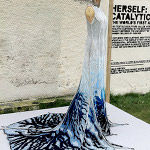The Centre for Sustainable Fashion's "catalytic clothing" strips pollutants out of the air and breaks them down harmlessly. Here's an atmospheric (ha) video of an air-purifying dress, but they've also got jeans, which significantly improves the chances of getting enough people wearing catalytic clothing to actually make a difference in air quality. (None of this is available for purchase or anything crazy like that, but in theory, if it were, you'd probably want the jeans.)
How are the pollutants broken down?
When the light shines on the photocatalyst, the electrons in the material are rearranged and they become more reactive. These electrons are then able to react with the water in the air and break it apart into 2 radicals. A radical is an extremely reactive molecule. These radicals then react with the pollutants and cause them to break down into non-harmful chemicals. …
How many people would need to participate to produce a noticeable reduction in the level of pollution?
An estimate of the required level of uptake for the Catalytic Clothing indicates that a significant reduction in the level of air borne pollutants in a large city such as London could be achieved if, for every metre of pavement width, 30 people wearing Catalytic Clothes walked past each minute.
Would someone wearing Catalytic Clothing be at a greater risk of exposure to pollutants?
No. The Catalytic Clothing technology won't actively attract any pollutants. Instead, it will break down anything that comes within very close proximity of the photocatalyst's surface.



